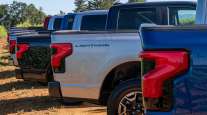Staff Reporter
California Charging Infrastructure Lags Behind Targets

[Stay on top of transportation news: Get TTNews in your inbox.]
The California Air Resources Board’s controversial Advanced Clean Fleets rule requires a phased-in transition toward zero-emission medium- and heavy-duty vehicles, but concerns are growing that the state is falling behind in its ability to provide enough charging options to meet its own aggressive targets.
Trucking advocates slammed the rule when it was announced April 28 and remain adamant that its goals, including the installation of 157,000 chargers capable of powering medium- and heavy-duty trucks, are unrealistic and too ambitious.
To meet the CARB deployment targets, around 300 chargers a week would need to be built, California Trucking Association CEO Eric Sauer told Transport Topics on Sept. 6. He said that is not happening, and stressed that the outlined pace is “just too soon, too fast.”
Part of the problem is the time needed for build-out. CTA members tell the trade association they are hearing 18-month construction times as best-case scenarios for building charging stations, with some forecasts stretching out to seven years, Sauer said.

Ryan Wheeler told TMC that utilities are being asked to move quicker than the two to five years that it typically takes to connect major projects. (Blake Franko/TMC)
Indeed, National Grid Fleet Electrification Product Owner Ryan Wheeler said during American Trucking Associations’ Technology & Maintenance Council’s 2023 Summer Conference & Fleet/Utility Forum in June that utilities typically take two to five years to connect major projects. Now they’re being asked to move much quicker.
Another problem is filing paperwork for local authorities, particularly when it comes to zoning. Even in California, EV charging is rarely the primary use for properties, and zoning codes for chargers as the primary use broadly don’t exist at a municipal level, said Thomas Ashley, Voltera Power vice president, government and utility relations. Ashley, whose company is looking to build charging infrastructure for vehicle categories including Class 8 trucks, said most of the regulatory focus has been on EV charging as a secondary use. Municipalities are motivated to work on this, he said, but the newness of the issue can lead to delays as the municipalities figure it out, he said.
Another problem is that many fleets do not own the property they use — it is often leased — and therefore the cost and responsibility of installation will fall to the owner, CTA’s Sauer said.

Rendering of a Voltera charging station. The company is also planning a charging facility near the Port of Long Beach. (Voltera)
These challenges aren’t slowing down interest, however, as there are plenty of companies trying to build new charging infrastructure in California — especially near ports. All drayage trucks will need to be zero-emission by 2035 under ACF, one of the first segments with that requirement.
Long Beach, Calif.-based WattEV said July 31 it had secured $40.5 million in grants to expand a network of electric truck stops into Northern California and Oregon, with some $34 million allocated for what the company said will be the nation’s largest electric charging depot. Located near Sacramento International Airport, the project is expected to open in the second half of 2025 with a combined 118 berths for medium- and heavy-duty commercial vehicles. In July, the developer opened a charging facility at the Port of Long Beach that can charge 26 trucks.
TeraWatt Infrastructure, meanwhile, plans to build seven charging centers between Long Beach and El Paso, Texas. The company has completed land acquisitions for its I-10 corridor locations, Peter Cohen, senior director of business development, told TT. Construction of the company’s charging stations will be staggered, he said.
San Francisco-based TeraWatt’s first sites will come online in early 2024, although Cohen declined to add more detail, saying no initial dates had yet been made public.
TeraWatt is looking at the regional hauling business first, but that will change, he said, adding that when the long-distance, heavy-duty trucks were ready, TeraWatt’s charging stations would be, too.
The company is focusing on buying sites rather than leasing because it offers more opportunities and options further down the line, he said. The company has raised $1 billion of seed money, he said, plenty of which is still available to spend.
Voltera, which inked a maintenance agreement with Amerit in January after launching in September 2022, is also planning a charging facility near the Port of Long Beach.
Want more news? Listen to today's daily briefing above or go here for more info
The company is close to going live with this first drayage project, said Ashley, but also teamed up with Class 8 manufacturer Nikola to offer a hydrogen fuel cell truck refueling business known as Hyla. The refueling business is part of Nikola’s pivot toward hydrogen and away from battery-electric trucks.
The initial CARB regulations under ACF apply to fleets with 50 trucks, but additional regulation for smaller fleets is expected in the coming years. The average fleet size among CTA membership is 32 trucks, said Sauer.
CARB is currently offering $83 million in incentives for smaller fleets seeking to buy Classes 2b-8 electric trucks. CARB is also expected to unveil proposed changes to its Low Carbon Fuel Standard that are likely to incorporate incentives for charging infrastructure in fall 2023, according to a source close to the agency.




